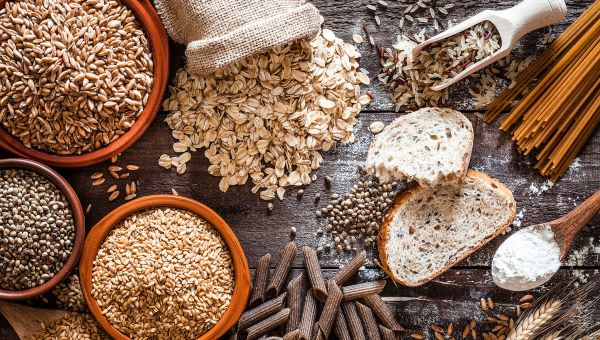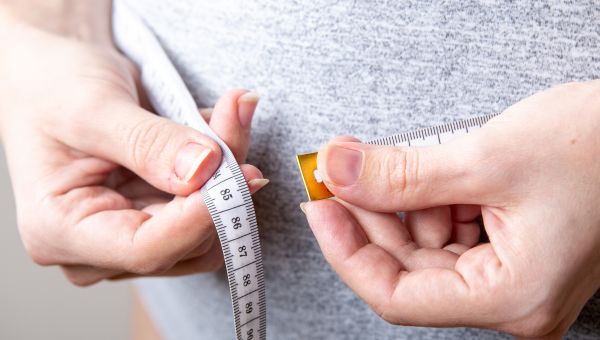9 Steps to a Healthy Weight
Get simple, everyday tricks to help manage your weight and reduce your waistline.
Updated on April 1, 2022

Does it seem like no matter what you do, you just can’t seem to lose weight in your midsection? Although cutting calories and getting more exercise can be a challenge, the effort is worth it: Getting rid of excess fat around your middle with a healthy weight loss plan is good for your overall health.
"It's the idea of where belly fat is located that makes it 'bad,'” says registered nutritionist and dietitian Frances Silva, MS, of Medical City Lewisville in Texas. “Belly fat accumulating around your organs can increase your chances of cardiovascular disease and type 2 diabetes."
Get tips from Silva and bariatric surgeon Matthew Fitzer, MD, of Reston Hospital Center in Virginia, on ways to address extra weight around your waist—and boost your overall health in the process.

Start by setting your goals
To get off to a successful start, set small, realistic, and specific goals. Instead of vague statements like "Eat better," try "Eat three servings of vegetables every day this week."
“It’s best to make small, incremental diet changes that you could stick to forever,” says Dr. Fitzer. “The weight loss you get with them is slower, but be patient. It will add up, and you will be much, much more likely to keep it in the long term.”

Try quick, at-home workouts
According to Fitzer, just 15 minutes of exercise per day can show positive body changes. Most adults should aim for 150 minutes of moderate-intensity exercise or 75 minutes of vigorous-intensity activity per week, according to the U.S. Department of Health and Human Services (DHHS). Keep in mind if you can get closer to 300 minutes of week of moderate exercise or 150 minutes of more strenuous activity, it’s even better. In fact, the more exercise you get, the greater the health benefits, experts advise.
But this activity doesn’t have to be done in lengthy workouts. Every bit of exercise counts toward your weekly goal—even a two-minute walk.
Not a gym junkie? Not a problem. Shoveling, gardening, dancing, and other low-impact activities you can do around the house all count as exercise that will work toward reducing your risk for a slew of chronic health issues, like heart disease and diabetes. Even opting for the stairs instead of riding the elevator at work can help you reach your health goals. And you don't have to buy a fancy fitness gadget to track your progress. Silva says a pedometer and even apps on your phone, such as the Sharecare app (available on iOS and Android), can help you get the job done just as well. Sharecare has a built-in steps counter, so you can easily track your progress. "I never want people to think that being healthy is expensive," she says.

Stick to good carbs
What are good carbs? The ones with a low glycemic index (GI)—a measure of how quickly foods break down and increase your blood sugar. The slower, the better. High-GI carbs create blood sugar spikes that are followed by sharp plunges—which make you hungry again. Over time, that roller coaster increases your risk of belly fat, heart disease, and diabetes. Good carbs include most fruits and vegetables; 100 percent whole grains like cereals, breads, crackers, whole-wheat pasta, couscous, and brown and wild rice; and beans, lentils and other legumes.

Give your kitchen a makeover
For a happier waistline, reduce your intake of foods loaded with saturated and trans fats to zero. These foods boost body-wide inflammation and can contribute to clogging up your arteries. Fitzer also recommends avoiding foods with added sugars, like sugary breakfast cereals, sugar-sweetened yogurts, soft drinks, and more. Those unhealthy, empty calories can fuel cravings. What's more, “because of their effect on the liver, they have an outsized result in producing belly fat," says Fitzer.

Squeeze in some strength training
“There is some evidence that weight training is better for belly fat than an equivalent amount of cardio,” says Fitzer. The current federal guidelines suggest doing muscle-strengthening activities two days per week. He stresses, however, any exercise, either cardio or strength, is better than none at all. The key is to find the physical activity you enjoy.
Not a fan of weight machines? No problem—you can use your own body weight: Try push-ups, core work, and stair climbing to build more calorie-burning muscle. Leg lifts can tighten your transverse abdominal muscles, which also strengthen your core. And don’t forget that yoga works to strength many of the muscles in your body.

Take time to relax
The bigger your waist, the higher your stress—and vice versa. Yoga, deep breathing and meditation can help prevent your body from releasing cortisol, the stress hormone that directs fat to your waist. Plus, releasing tension can also ease stress eating. Figure out what triggers your anxiety and develop strategies to cope when they arise.

Eat well
Some good news: if you want to reduce belly fat, you have to eat. Yep, that's right. Don't starve yourself. Research shows that dieting too intensely may foster the conditions that contribute to adding belly fat, not subtracting it. Watch portion sizes, choose healthy foods, be aware of how many times you visit the snack cupboard, but don't make things too difficult by obsessing over it.
Another weight loss tip to remember: don't forgo a healthy breakfast. "Most people eat more net calories per day after skipping breakfast than they would have if they’d just had breakfast,” says Fitzer.

Track your progress
Instead of watching the scale—a habit that can have mixed results when it comes to losing weight—keep tabs on your waistline by measuring it weekly. If your waist measurement at your belly button, with you sucking in, is more than half your height, your waistline may suggest risk. If your waist is bigger than 35 inches (women) or 40 inches (men), there's no time like the present to whittle your middle.

Reward yourself
This is the best part. When you meet your weekly or monthly goals, promise to treat yourself to something that will push you to keep on going, like new workout gear or a session with a personal trainer. And keep celebrating your successes. Brag about them on social media. When you stay consistent and accountable for your efforts, you increase your chances of success.
More On


video

article

slideshow


video


video
